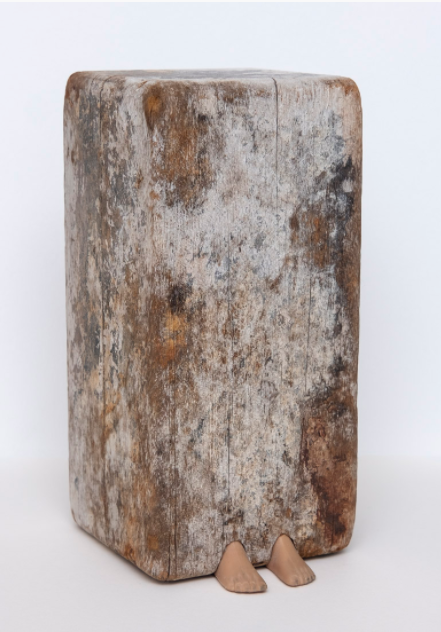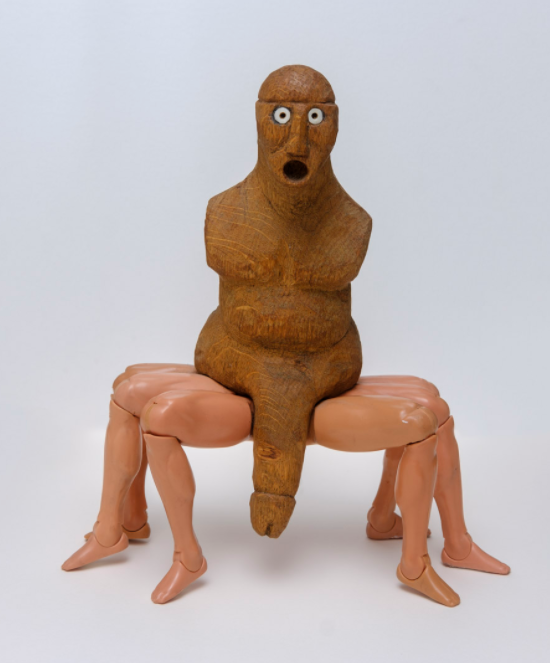

Inuk Silis Høegh // Kunuk & Kaali
Inuk Silis Høegh (b.1972) has created eight figures of driftwood and plastic bone, inspired by the traditional figurative characteristics of the old tupilaks and wooden figures. Two of the eight figures, Kunuk (2003) and Kaali (2003), are part of the Nuuk Art Museum’s permanent collection.
Silis Høegh’s two wooden sculptures of wood, bone and plastic reference the traditional spirit creatures of the Greenlandic East Coast, fusing them with pop culture toys. Two worlds meet in the raw material and toy kitsch – spooky meets playful. Kaali and Kunuk are Greenlandised names of the European-Danish names Karl and Knud. They are part of an “army” of eight figures that were initially exhibited together at Nordatlantens Brygge with the work titles “Bodies I and II”.
Kaali (2003)
With the figure Kaali, Silis Høegh has taken direct inspiration from a male figure from the east coast of Greenland, which was collected by eskimologist Therkel Mathiassen in 1931-1932. Kaali is carved in the same shape as the torso of this figure, which has wild and wide-open eyes and is carved from driftwood. The white eyes are carved from bone. The original figure is in the National Museum in Copenhagen and is believed to be a fertility effigy. It is 15 cm tall, has no arms and a black-coloured phallus. The black colour was considered a dangerous colour with the spirit Aajumaaq, as anything its black limbs touched would rot and die (Kaalund, 1979).
If you’ve seen this male figure, you’ll immediately recognise the creepy, bulging eyes of Kaali. However, the male genitals are without the black colour, and the two wooden legs are replaced by six plastic action man legs, which are mounted on Kaali’s “soft” pear-shaped torso. Silis Høegh plays with both the figurative characteristics of traditional wooden figures and the toy universe of popular culture. The fantasies of both these worlds manifest themselves in the figure. The notions of what traditional Greenlandic art is and what modern popular culture is are challenged and merged in Kaali. In the collision between plastic legs and the driftwood figure, Kaali juxtaposes opposites; the old is set against the new, the organic against the inorganic and an old fertility figure is contrasted with an ideal plastic body from an action man or Barbie.
The character is creepy and humorous, recognisable and playful. You can’t take your eyes off the expressive Kaali after glancing at him for the first time.
Kunuk (2003)
The figure Kunuk is a block consisting of one piece of square, symmetrical driftwood with two plastic feet from an action man at the bottom. It’s as if Kunuk is hiding – a nice contrast to his expressive “brother”, the aforementioned Kaali.
The figure draws attention to the material. On the back, there’s faded writing on the driftwood, making you wonder where the driftwood comes from. With the two actionman plastic feet contrasting with the driftwood, we find ourselves in a playful and imaginative universe where even the wooden block has a playful and humorous character. What would Kunuk say if he could talk? In the colouring book TUPILAK, a tupilak character meets Kunuk and says: “He’s a bit shy, that one. He doesn’t want to be silly or scary – maybe he just wants to be himself.” There’s a mystery and a question of what creepy or silly things Kunuk might harbour – if anything at all. Kunuk feels like an analogue and encrypted code to be cracked.
Both Kunuk and Kaali are small figures with big personalities that play with your attention.
The artist Inuk Silis Høegh was born in 1972 in Qaqortoq. He has a degree in film and television production from Bristol University. Visual art, conceptual art, installations and film art are all part of Silis Høegh’s artistic practice.
This article was written by Laura Lentz, 2021.
- Kaalund, Bodil: Grønlands Kunst. Skulptur, Brugskunst, Maleri, Samtidskunst. Gyldendal. 1.udgave 1979. 3. reviderede og udvidede udgave u.å.
- Hansen, Stine Lundberg: Bagom Værket “Tupilak – tungen som sprog”. Nuuk Kunstmuseum. www.nuukkunstmuseum.com/ da/bagom-vaerket/tupilakkernes-billedsprog-tungen/
- Hansen, Stine Lundberg: TUPILAK. Milik publishing, Nuuk Kunstmuseum. 2020. 1. oplag, 1. udgave.
